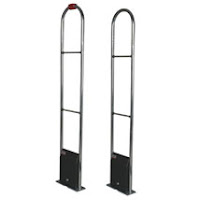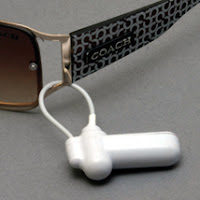
Shoplifting is a problem faced by all retailers but, according to experts, shoplifting theft can be reduced by 60% when using a reliable Electronic Article Surveillance system (EAS). The two most widely used EAS systems are Radio Frequency (RF) and Acousto-magnetic (AM). The question most business owners ask is “Which security system should I use in my store?”
I took this question, and several others, to Julie Mitchell, Merchandising Manager at Specialty Store Services and all-around knowledgeable and helpful person.
Just how do the RF and AM systems work?
The RF system works like this: a label or small hard tag—basically a miniature, disposable electronic circuit and antenna—is attached to a product and responds to a specific frequency emitted by a transmitter antenna, usually one pedestal of an entry/exit gate. The response from the label is then picked up by an adjacent receiver antenna. This processes the label response signal and will trigger an alarm when it matches specific criteria. The most popular RF is 8.2MHz.
With the AM system, a transmitter creates a surveillance area where hard tags and soft labels are detected. The transmitter sends a radio frequency signal in pulses, which energize the tag in the surveillance zone. When the pulse ends, the tag responds, emitting a single frequency signal. While the transmitter is off between pulses, the tag signal is detected by a receiver. If the correct criteria is met, an alarm occurs.
What are the advantages and disadvantages of the RF and AM systems?
The RF system is the most widely used system in the United States. The tags and labels are getting increasingly smaller, which is beneficial from a visual standpoint. The RF system is not as sensitive as the AM system but it is also less expensive, which makes it an economical choice for small and mid-level retail stores. The tags and labels, however, are slightly more expensive than AM tags and labels.
The AM system was the first EAS system in the market and is used in most large high-end retail stores and other large retail, hardware, appliance and discount stores. The AM system is very sensitive, which means that there are sometimes false alarms. AM tags work well when they are close to metal and so the AM system works well in stores that use metal shopping carts.

What type of security tags or labels are available?
Both security systems use hard security tags and soft security labels specific to each system, available deactivatable and non-deactivatable. Soft labels are ideal for use with books, media, and any merchandise with a hard, flat surface. Hard tags are perfect for use with clothing. Hard tags are also available as blister pack tags for pegged items, loop tags for sunglasses and shoes, box wrap alarms, and loop bottle tags for wine and liquor bottles.
How are security tags and labels deactivated?
